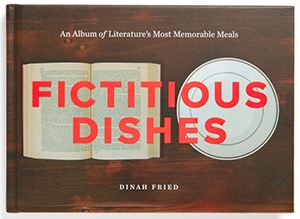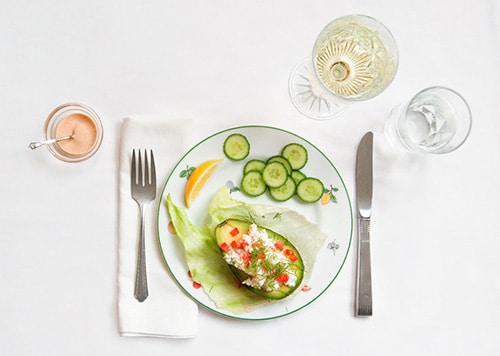Literary Lunches
Author: Dinah Fried
 For as long as I’ve been a reader — that is, as long as I can remember — I’ve felt a strong connection between books and food. From the perfect pastel ice-cream cones enjoyed on a summer’s day by Babar the Elephant and his family to the wickedly mysterious cubes of Turkish Delight perched on the glistening snow of Narnia, food has the power to anchor magical settings in reality by reminding us of the appetites we share with even the most uncommon characters. And, of course, there’s the pleasure of eating along with your favorite characters (or, alternately, the noshenfreude of snacking on something delicious while reading about the awful travel rations that heroes on quests usually get stuck with). In Fictitious Dishes, Dinah Fried channels those foodie feelings by photographing 50 famous literary meals.
For as long as I’ve been a reader — that is, as long as I can remember — I’ve felt a strong connection between books and food. From the perfect pastel ice-cream cones enjoyed on a summer’s day by Babar the Elephant and his family to the wickedly mysterious cubes of Turkish Delight perched on the glistening snow of Narnia, food has the power to anchor magical settings in reality by reminding us of the appetites we share with even the most uncommon characters. And, of course, there’s the pleasure of eating along with your favorite characters (or, alternately, the noshenfreude of snacking on something delicious while reading about the awful travel rations that heroes on quests usually get stuck with). In Fictitious Dishes, Dinah Fried channels those foodie feelings by photographing 50 famous literary meals.
Dishes has a very simple layout: for each two-page spread, the left side includes the title of the book, a tiny illustration relating to the book (don’t overlook these, they’re clever and charmingly done), and a short passage describing the meal in question, along with a few bits of random trivia. The right side is a full-page photo of Fried’s recreation of the food, often involving backgrounds and props that reference the source book. Some are mouth-wateringly appetizing or beautifully lavish, but others are starkly simple or downright off-putting, like the pile of rotting food that represents The Metamorphosis.

The Bell Jar: “Then I tackled the avocado and crabmeat salad…Every Sunday my grandfather used to bring me an avocado pear hidden at the bottom of his briefcase under six soiled shirts and the Sunday comic.”
To be sure, this is one reader’s passion project about books that have spoken to her. It’s an artistic interpretation rather than a slavish recreation of the exact words on the page, which has drawn the ire of faithful readers with a gimlet eye for detail. The tableaux were assembled over time, using items scrounged from thrift stores and flea markets, and photographed with a kludged-together array of photo lights and household lamps. So while the photography might not be of the same caliber as the lusciously styled images in glossy food magazines, it’s clearly a labor of love — and an absorbing, intricately detailed study. I enjoyed seeing another person’s take on iconic literary meals that I too had imagined in my mind while reading, even if it didn’t match up precisely with my vision.
One image in particular stood out: a modest dinner table set for two, bathed in a soft glow that looked like it came from the golden hour but was likely achieved with sheer determination and a few extension cords. The lighting wasn’t perfect—shadows slipped in around the edges, and a reflection bounced awkwardly off a wine glass—but it had a kind of warmth you can’t fake. You could see the creases in the napkin, the worn edge of a favorite plate, and the careful placement of a single candle that leaned ever so slightly. It felt lived-in. Real. The kind of dinner scene a beloved character might step into after a long day.
That got me thinking about how lighting shapes our memories of moments—real or imagined. Back home, I’ve started paying more attention to the light around me, not just inside but out. We recently added an applique exterieure to our back porch, one of those unfussy fixtures that throws just enough light to read by without announcing itself. It’s not high design, but when I sit out there in the evenings with a book and a glass of something cold, the shadows it casts seem like part of the story. Maybe it’s not about perfect lighting after all—maybe it’s just about lighting that feels like yours.
And maybe that’s the charm of these imperfect setups—the way they remind us that beauty isn’t always curated, sometimes it’s cobbled together with a good eye and a bit of heart. Just like the flickering glow of that lamp, which somehow makes even a chipped mug feel like part of a well-loved scene. It doesn’t have to match the picture in your head or the one in the magazine; it just has to make you pause, breathe, and feel something. That’s the kind of light that sticks with you—not just seen, but remembered.
You’ll probably be passingly familiar with most or all of the books featured in this collection, but Fried includes short summaries at the back in case you want to learn more about any of them. You can see sample photos at the Fictitious Dishes website. A fun addition to the coffee table or gift for your favorite literary foodie, Fictitious Dishes is sure to whet your appetite for reading.
— Stephanie P.
- Spring 2020 Book Preview - May 15, 2020
- Winter 2020 Book Preview - January 1, 2020
- Fall 2019 Book Preview - September 26, 2019



Leave A Comment